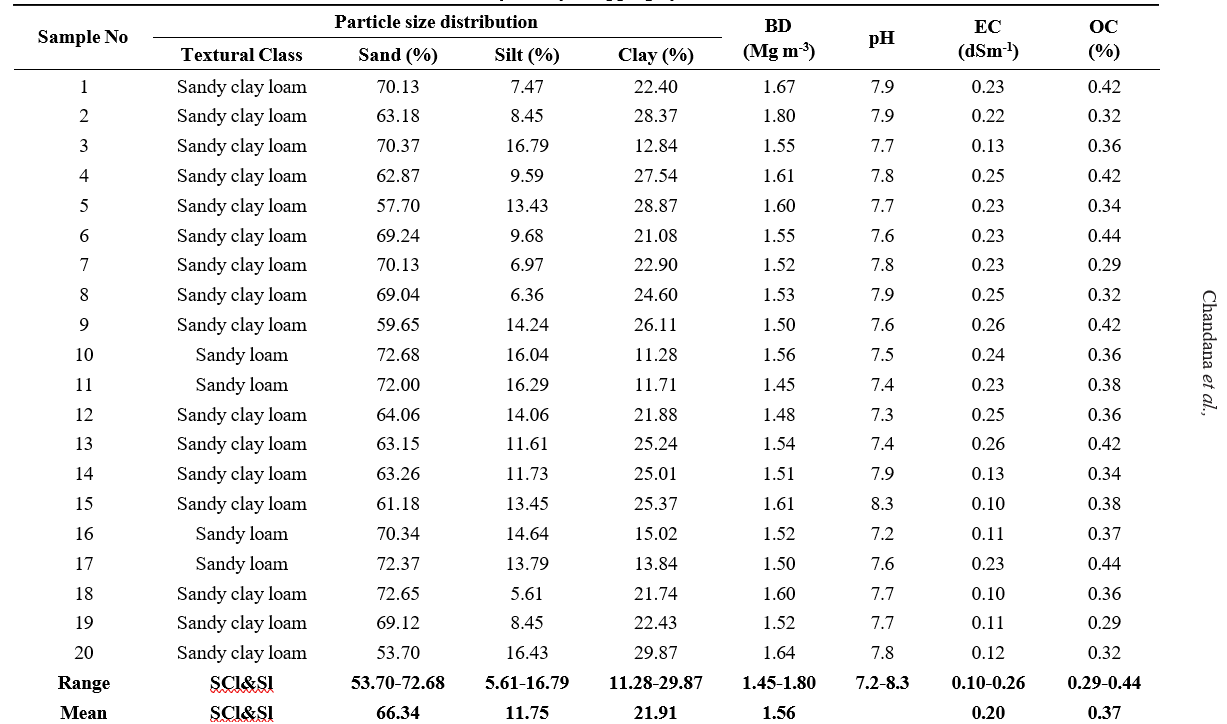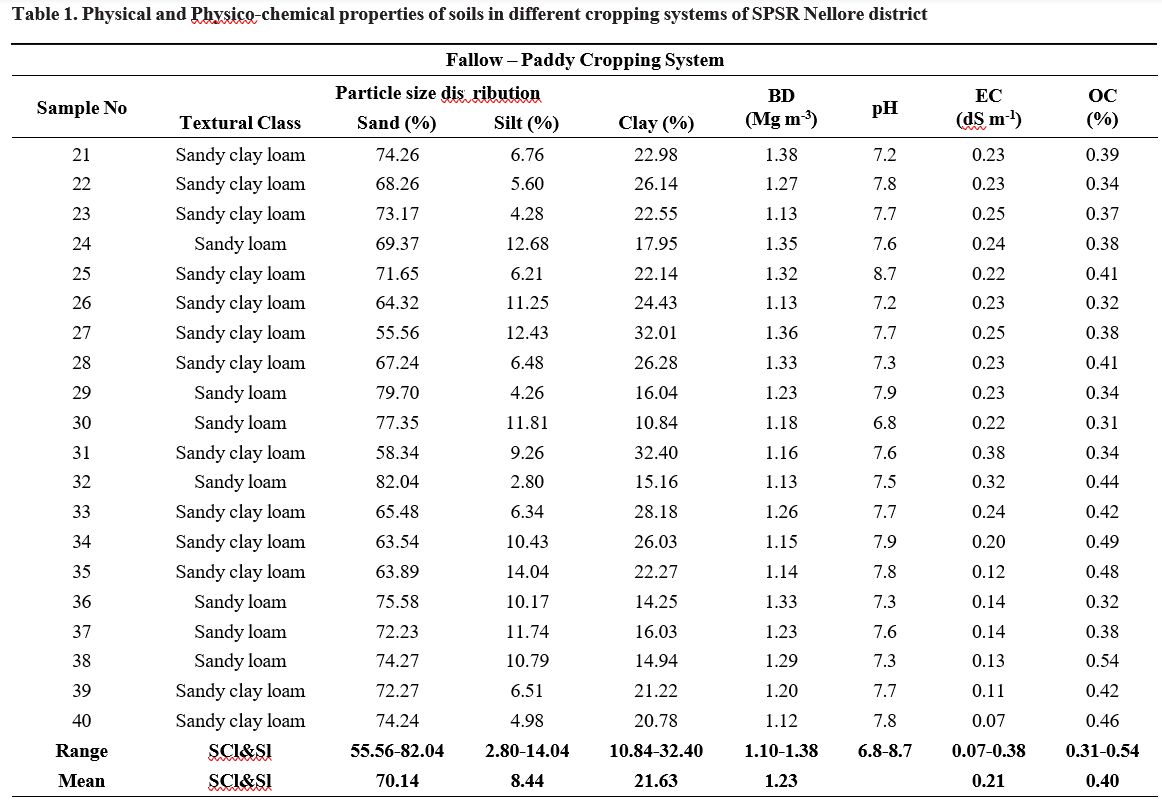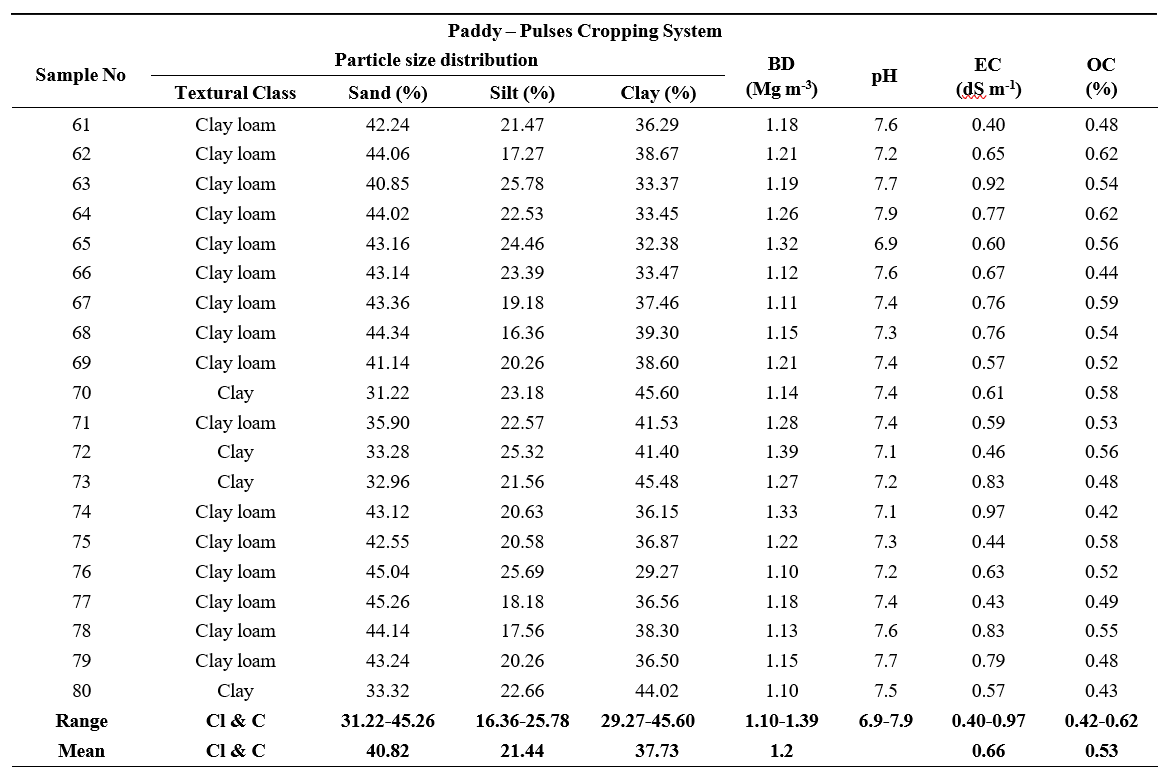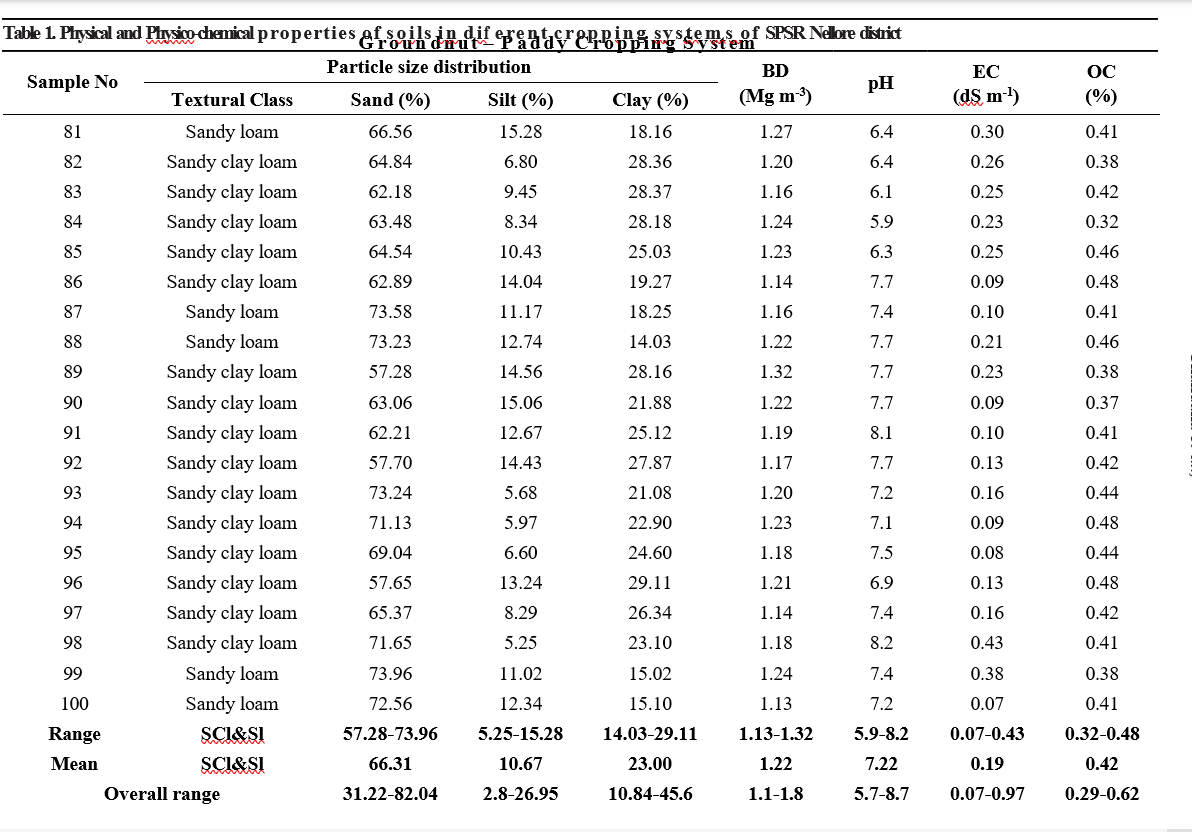Soil Physical and Physico-Chemical Properties as Influenced by Cropping Systems in Spsr Nellore District, Andhra Pradesh, India
0 Views
CHANDANA*, B. VAJANTHA, M. SREENIVASA CHARI, U. VINEETHA AND M.V.S. NAIDU
Department of Soil Science And Agricultural Chemistry, S.V. Agricultural College, ANGRAU, Tirupati-517 502.
ABSTRACT
Soil physical, physico-chemical properties are important for favourable crop growth and maintaining soil health. Cropping
systems exert significant influence on soil properties which effects crop yield. Keeping this view, a study was taken up to know the effect of major cropping systems on soil physical and physico-chemical properties in SPSR Nellore district, Andhra Pradesh, India. Totally 100 soil samples were collected from five major cropping systems viz., paddy-paddy, fallow-paddy, paddy-cotton, paddy-pulses and groundnut-paddy (20 samples from each cropping systems) in SPSR Nellore district analysed for texture, bulk density, pH, EC and organic carbon. The results revealed that the texture of soils under study in different cropping systems are sandy clay loam, sandy loam, clay loam and clay. The bulk density of soil varied from 1.10 Mg m-3 in fallow-paddy, paddy- pulses cropping systems to 1.80 Mg m-3 in paddy-paddy cropping systems. The pH of soils varied from 5.7 (slightly acidic) in paddy-cotton cropping system to 8.7 (strongly alkaline) in paddy-pulses cropping system. The EC of soils varied from 0.07 dS m-1 in fallow- paddy cropping system to 0.9 dS m-1 in paddy-pulses cropping system. The organic carbon varied from 0.29 per cent in paddy-paddy cropping system to 0.62 per cent in paddy-pulses cropping system.
KEYWORDS: Cropping systems, Soil physical and physico-chemical properties, SPSR Nellore district.
INTRODUCTION
Soil serves as a crucial medium for plant growth and its physical and physico-chemical properties significantly influence its fertility, structure and overall health. Different cropping systems have distinct effects and understanding these properties is essential for effective soil management and sustainable agricultural practices. For instance, diverse crop rotations often enhance soil structure, improve nutrient balance and increase organic matter content compared to monoculture systems, which may lead to nutrient depletion and soil degradation. The physical properties, such as soil texture, bulk density influence the soil’s ability to support plant growth, manage water and ensure proper aeration. Meanwhile, the physico-chemical properties, including soil pH, EC, organic carbon determine the soil’s fertility and its capacity to sustain crop yields. In this connection, the effect of cropping systems on soil physical and physico chemical properties in SPSR Nellore district was studied.
MATERIAL AND METHODS
The study area SPSR Nellore district lies in between 14° 4′ 12.9″ and 140 57′ 56.8′′ latitude and 79030′29.6′′and 8004′24.7′′ longitude and the investigation was carried in the year 2024. One hundred soil samples were collected from five cropping systems viz., paddy-paddy, fallow- paddy, paddy-cotton, paddy-pulses and groundnut- paddy. From each cropping system 20 samples were collected. All the samples were analyzed for pH, EC, organic carbon following the standard procedures (Jackson, 1973). Particle size distribution of the soils was determined by Bouyoucous hydrometer method as described by Baruah and Barthakur (1997). Based on particle size distribution, textural classification was given using the nomograph (textural diagram) of USDA. Bulk density of soil samples were determined by following Keen Raczkowski’s method as described by Sankaram (1966). Soil samples were rated as low, medium and high categories as per the limits suggested by Ahmed et al. (2007) for pH, EC and organic carbon.
RESULTS AND DISCUSSION
The data pertaining to soil physical and physico- chemical properties under different cropping systems in SPSR Nellore district was presented in Table 1.
Particle size distribution
Influence of cropping systems on soil physical and physio chemical properties
The texture of soils under different cropping systems were sandy clay loam, sandy loam, clay loam and clay in type. In the cropping system study percent of sand varied from 31.22 to 82.04, silt 2.80 to 26.95 and clay ranged from 10.84 to 45.60. In paddy-paddy, fallow-paddy and groundnut-paddy cropping systems observed texture is sandy clay loam to sandy loam in texture while in paddy-cotton cropping system observed texture is sandy clay loam to clay loam. Fine textured clay loam to clay texture was noticed in cropping systems of paddy-pulses.
Variations in topographic situation, type of parent material, in situ weathering, clay translocation and soil age were considered as major factors to cause variations in soil texture. According to Charan et al. (2021), the soils in different cropping systems of Nellore district showed sandy clay loam to clay in soil texture.
Bulk density
The BD data presented in Table 1and is deduced that the bulk density of soils varied from 1.10 Mg m-3 in fallow-paddy, paddy-pulses and paddy-groundnut cropping systems to1.80 Mg m-3 in paddy-paddy cropping systems. The bulk density of soils in paddy- paddy, fallow-paddy, paddy-cotton, paddy-pulses and groundnut-paddy cropping systems was ranged from 1.45-1.8, 1.1-1.38, 1.35-1.66, 1.1-1.39 and 1.13-1.32 Mg m-3, respectively with a mean value of 1.56, 1.23, 1.54, 1.20 and 1.20 Mg m-3, respectively. The lowest mean bulk density was observed in paddy-pulses as 1.20 Mg m-3, paddy-groundnut 1.20 Mg m-3, fallow-paddy (1.23 Mg m-3, paddy-cotton 1.54 Mg m-3 and paddy-paddy cropping system 1.56 Mg m-3.
The highest bulk density was observed in paddy- paddy cropping system due to compaction of the top soil by repeated ploughing and puddling. Similar results were reported by Selassie and Ayanna (2013). The lowest bulk density was found under paddy-pulses and fallow- paddy cropping system due to higher amount of added biomass from leguminous crops made soil loose, porous and less squeezed (Kumar et al., 2020).
Physico – Chemical Properties Of Soils In Different Cropping Systems
The physico-chemical properties of soil samples under different cropping systems of SPSR Nellore district are presented in Table 1.
The pH of soils varied from 5.7 (slightly acidic) in paddy-cotton cropping system to 8.7 and (strongly alkaline) in fallow-paddy. The pH of soils in paddy- paddy, fallow-paddy, paddy-cotton, paddy-pulses and paddy-groundnut cropping systems were ranged from 7.2-8.3, 6.8-8.7, 5.7-8.1, 6.9-7.9 and 5.9-8.2, respectively.
The highest pH was recorded in soils of paddy- pulses cropping system and lowest in groundnut-paddy. This variations in soil reaction of different cropping systems is due to parent material from which soils were developed and due to the fact that continuous submerged conditions in paddy which might be resulted in lowering the pH of soils. Similar findings were also made by Bhatt et al. (2018) under the soils of rice-wheat cropping system.
Electrical Conductivity (EC)
The data pertaining to soil EC was presented in Table 1 and reveals that, the soils of major cropping systems in SPSR Nellore district were non-saline and are showing less than 4 dS m-1.
The EC of soils varied from 0.07 dS m-1 in fallow- paddy cropping system to 0.97 dS m-1 in paddy-pulses cropping system. The EC of soils in paddy-paddy, fallow-paddy, paddy-cotton, paddy-pulses and paddy- groundnut cropping systems are ranged from 0.10-0.26, 0.07-0.38, 0.08-0.30, 0.40-0.97 and 0.07-0.43 dS m-1 respectively with a mean value of 0.20, 0.21, 0.17 ,0.66 and 0.19 respectively. The mean EC in different cropping systems were in the order of paddy-cotton (0.17 dS m-1) followed by paddy-groundnut (0.19 dS m-1), paddy- paddy (0.20 dS m-1), fallow-paddy (0.21 dS m-1) and paddy-pulses (0.66 dS m-1).
The maximum EC of 0.97 dS m-1 was observed in soils of paddy-pulses cropping system in soils and minimum value of EC (0.07 dS m-1) was observed in paddy-cotton cropping system soils. The soils in all cropping systems are non-saline with respect to soluble salt concentration. The data further revealed that because of good drainage condition, soil EC is within the normal range and soils are highly favorable to crop growth as they are free from salinity problem. The normal EC may be ascribed to leaching of salts to lower horizons. (Sharmaet al., 2008).
Organic Carbon (OC)
The organic carbon of major cropping systems in SPSR Nellore district are low (0.29%) to medium (0.62%).
The organic carbon varied from 0.29 per cent in paddy-paddy cropping system to 0.62 per cent in paddy- pulses cropping system. The organic carbon of soils in paddy-paddy, fallow-paddy, paddy-cotton, paddy-pulses
Table 1. Physical and Physico-chemical properties of soils in different cropping systems of SPSR Nellore district





and groundnut-paddy cropping systems are ranged from 0.29-0.44, 0.31-0.54, 0.34-0.55, 0.42-0.62 and 0.32- 0.48 per cent, respectively with a mean value of 0.37, 0.40, 0.44, 0.53 and 0.42 per cent, respectively. The mean organic carbon of studied cropping systems are in the order of 0.37%, 0.40%, 0.42%, 0.44 % and 0.53% in paddy-paddy followed by fallow-paddy, groundnut- paddy, paddy-cotton and paddy-pulses cropping system respectively. The studied cropping systems falls in low to medium in organic carbon status.
The paddy-pulses cropping system showed higher OC than that of other cropping systems due to legume crop in the sequence might be having high root biomass, higher carbon sequestration and less carbon release than that of soils under other cropping systems. Similar findings were also made by Rajpoot et al. (2021) in rice- based cropping systems. The higher OC in paddy-pulses cropping system is also due to decomposition of fallen leaves and root biomass leads to improve the OC in soils. (Kumar et al.,2019).
In conclusions, the soils of SPSR Nellore district are sandy clay loam, sandy loam, clay loam and clay in type. The bulk density of soil varied from 1.10 Mg m-3 to1.80 Mg m-3. The pH was slightly acidic to strongly alkaline in reaction and non-saline in nature. The organic carbon content was low to medium in range. The results underscore the importance of adopting diversified cropping systems to maintain and enhance soil health. Further pulse crops in cropping system are helping in improving organic carbon. Sustainable agricultural practices that can improve further the soil physical and physico-chemical properties in the cropping sequences of SPSR district.
LITERATURE CITED
Ahmed, S.R., Reddy, D.V.R., Muralidharudu, Y and Rao, A.S. 2007. Soil test based fertilizer application. ICAR, ANGRAU and dept. of Agriculture, Andhra Pradesh. ANGRAU press, Hyderabad.34-35.
Baruah, T.C and Barthakur, H.P. 1997. A text book of soil analysis. Vikas Publishing House Pvt. Ltd., New Delhi. Bhatt, M.K., Raverkar, K.P., Labanya, R and Bhatt,
C.K. 2018. Effects oflong-termbalancedandimbal anceduseofinorganicfertilizersandorganic manure (FYM) on soil chemical properties and yield of rice under rice-wheat cropping system. Journal of Pharmacognosy and Phytochemistry.7(3): 703-708.
Bouyoucos, G.J. 1962. Hydrometer method improved for making particle size analysis of soil. Agronomy Journal. 54 (5): 464-465.
Charan, G.R., Munaswamy, V., Krishna, T. G and Subramanyam, D. 2021. Dynamics of soil potassium under different cropping systems in YSR Kadapa District of Andhra Pradesh, India. Soil Science Research Network.
Devi, P.A.V and Naidu M.V.S. 2015. Nutrient status of sugarcane growing soils of chittoor district in Andhrapradesh. BIOINFOLET 12 (4A): 864- 872.
Jackson, M.L. 1973. Soil Chemical Analysis. Oxford IBH Publishing House, Bombay.38.
Kumar, U., Mishra, V.N., Kumar, N., Dotaniya, C.K and Mohbe, S.2019. Effects of long term rice-based cropping systems on soil quality indicators in central plain of Chhattisgarh. International Journal of Current Microbiology and Applied Sciences. 8(4): 1544-1552.
Kumar, V., Singh, S.K., Singh, P., Tiwari, S., N and, M.M., Chiranjeeb, Kand Majhi, M. 2020. Effects of Cropping Systems on Soil Properties and Enzymatic Activities in Calcareous Soil.International Journal of Current Microbiology and Applied Sciences. 9(4): 1255-1262.
Rajpoot, R.S., Bajpai, R.K., Shrivastava, L.K., Kumar, U., Tedia, K and Mishra, V.N. 2021. Evaluation of soil physical and chemical properties under rice- based cropping system in Alfisols of Northern Hill Region of Chhattisgarh. International Journal of Current Microbiology and Applied Sciences.10(1): 2748-2761.
Sankaram, A.1966. A laboratory Manual for Agricultural Chemistry. Published by Jaya Singer Asia Publishing House, Bombay.56-57.
Selassie, Y.G and Ayanna, G. 2013. Effects of different land use systems on selected physico-chemical properties of soils in Northwestern Ethiopia. Journal of agricultural science. 5(4): 112.
Sharma, P.K., AnilSood, R.K., Setia, N.S., Tur Deepak and Harpinder Singh. 2008. Mapping of micronutrients in soils of Amritsar district, Punjab-A GIS Approach. Journal of the Indian Society of Soil Science. 56: 34-41.
- Influence of Organic Manures and Organic Foliar Sprays On Growth and Yield of Groundnut (Arachis Hypogaea L.)
- An Economic Analysis of Community Hiring Centres (Chcs) in Chittoor District of Andhra Pradesh
- Survey for the Occurrence of Yellow Mosaic Disease in Major Pigeon Pea Growing Areas in Andhra Pradesh
- Effect of Vigour Levels on Seed Quality Attributes of Groundnut Varieties
- Assessment of Soil Major Nutrients in Scarce Rainfall Zone of Andhra Pradesh
- Nutrient Uptake, Post-Harvest Soil Available Nutrient Status and Yield as Influenced by Varieties and Plant Geometries of Redgram

